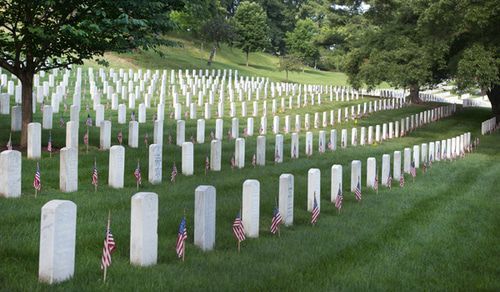Via Instapundit:
THE NEW YORK TIMES HONORS MEMORIAL DAY AS ONLY THEY CAN: Why Does the U.S. Military Celebrate White Supremacy?
I'd seen this vile thing, but unlike Instapundit, and actor James Woods below, I had failed to connect it to Memorial Day:
Can't load tweet https://twitter.com/RealJamesWoods/status/1264613105645973504: Unknown MIME type: text/html
What the New York Times Editorial Board is condemning is the existence of places like Fort Bragg, home of the Airborne, which commemorates Confederate General (and graduate of West Point) Braxton Bragg.
After crowing about its success in linking the Confederate Battle Flag to "white supremacy" and banning it, in Orwellian fashion, everywhere from stores to statehouses, after Dylann Roof's Charleston mass shooting, the New York Times goes on:
This same toxic legacy clings to the 10 United States military installations across the South that were named for Confederate Army officers during the first half of the 20th century. Apologists often describe the names as a necessary gesture of reconciliation in the wake of the Civil War. In truth, the namings reflect a federal embrace of white supremacy that found its most poisonous expression in military installations where black servicemen were deliberately placed under the command of white Southerners — who were said to better “understand” Negroes — and confined to substandard housing, segregated transportation systems and even “colored only” seating in movie houses. (Link in original)
The post-war reconciliation between North and South—
based on
mutual respect between the
mostly white combatants on both sides—may have been the most important factor in
America's rise to world greatness.
Memorial Day is about honoring America's war dead, and in a way, symbolizes the reconciliation of the two sides.
Memorial Day came into being after the Civil War, as "Decoration Day," a day for memorializing the honored dead, of whom there were a great many, by decorating their graves with flowers.
![]() Because America remained divided, there were actually two Memorial Days celebrated—many parts of the South still proclaim "Confederate Memorial Day" on a different date. The women of Columbus, Mississippi famously decorated the graves of soldiers on both sides in April of 1866, giving rise to a celebrated poem by Francis Miles Finch:
Because America remained divided, there were actually two Memorial Days celebrated—many parts of the South still proclaim "Confederate Memorial Day" on a different date. The women of Columbus, Mississippi famously decorated the graves of soldiers on both sides in April of 1866, giving rise to a celebrated poem by Francis Miles Finch:
No more shall the war cry sever,
Or the winding rivers be red;
They banish our anger forever
When they laurel the graves of our dead!
Under the sod and the dew,
Waiting the judgment-day;
Love and tears for the Blue,
Tears and love for the Gray.
There have been enough foreign wars since then that Northern and Southern bodies are found in military cemeteries in about equal measure. That North and South were fighting external enemies together was part of the Great Reconciliation that is described in Paul H. Buck's 1937 book, The Road To Reunion 1865-1900. (This book is now unpopular—and so is the actual post-Civil War reconciliation.)
So on this Memorial Day, it's important to remember that both the people who thought they were dying to make men free and those who thought they were fighting for their liberty with treasure, blood, and toil were Americans.
The New York Times, on the other hand, is staffed by people like Sarah Jeong.
Previous Memorial Day Columns
- May 26, 2019 Memorial Day Is About America’s Fallen (Mostly White Male) Soldiers—Not About Self-Absorbed Black Female Officers With Discipline Problems
- June 1, 2018 Derb's May Diary: The Forever War, The Diverse Army, And The Vanishing White Male, Etc.
- May 28, 2018 Memorial Day, 2018—They Didn't Die For Open Borders
- May 29, 2017 Memorial Day, 2017: Remembering Kevin O'Brien, An American Soldier Who Fought The Good Fight By James Fulford
- May 30, 2016 Who’s Desecrating Memorials On Memorial Day? Mostly Blacks And Hispanics By James Fulford
- May 25, 2015 More Memorial Day Meditations: Electing a New, Illegal Alien Military—With RINO Support By James Kirkpatrick
- May 24, 2015 Memorial Day Meditation: Obama Creating A New “Hollow Army”—But Many Servicemen Still Want To Defend The Southern Border By Joseph Swing
- May 28, 2012 On Memorial Day: When Veterans Come Home, Will Immigrants Have Taken Their Jobs? By James Fulford
- May 27, 2011 Supreme Court's Whiting Ruling Gives Patriots A Memorial Day Present By Washington Watcher
- May 30, 2010 Memorial Day, The Posse Comitatus Act, and Immigrant Enemies By James Fulford
- May 22, 2009 On Memorial Day: A Look Into My Family Scrapbook By Joe Guzzardi
- May 23, 2008 View From Lodi CA: Memorial Day In My English As a Second Language Class By Joe Guzzardi
- May 27, 2007 Fort Dix, Memorial Day, And Immigration By James Fulford
- May 26, 2006 McCain Musings On Memorial Day Weekend By Joe Guzzardi
- May 30, 2005 Cashing in on Memorial Day [Dave Gorak Blog]
- May 23, 2005 Immigration Summit on Memorial Day [Joe Guzzardi Blog]
- May 28, 2004 An Immigrant Bright Spot On Memorial Day By Joe Guzzardi
- May 25, 2003 A Memorial Day Meditation On Mesopotamia, Mexico And The Border Problem By Steve Sailer
- May 22, 2003 On Memorial Day, Remember The Dead—And The Living By Michelle Malkin
- May 26, 2001 Memorializing…Guess What? By Chilton Williamson Jr.




 Because America
Because America 








